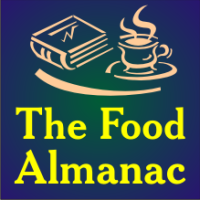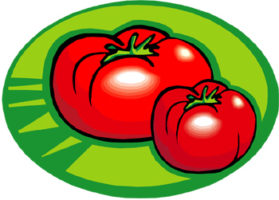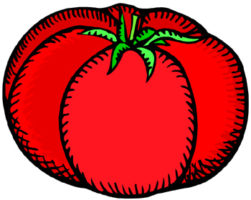 October 12, 2017
October 12, 2017
Days Until. . .
Halloween: 19 Thanksgiving (Nov. 23): 42
Turning Points In Eating
Christopher Columbus landed on an island in the Bahamas today in 1492. He didn't "discover" America--lots of people were here already. Perhaps even a few Europeans--Viking stragglers whose forebears arrived a few hundred years before. What Columbus instituted was a major cultural exchange between Europe and the Americas. Part of that was the greatest culinary revolution in human history, as hundreds of new ingredients from the New World made their way to Europe. Within a relatively few years, they changed the way most people cooked. Most noteworthy among these were potatoes, chocolate, the entire range of chile peppers, many strains of leguminous beans. . . and the tomato.
Today's Flavor
In honor of the arrival of Columbus on these shores, today is World Tomato Day. Of all the native American vegetables that made their ways to Europe after the voyages of Columbus, the tomato had the most widespread effect. Tomatoes are now eaten almost everywhere in the world, including the Far East. Imagine Italian cuisine without tomatoes!
 Tomatoes were originally regarded as poisonous by Europeans. They were sort of right: except for the tomato fruit itself, the plant is toxic, a member of the nightshade family (as are potatoes and eggplants). Once that myth was put to rest, a different one grew: that the tomato was an aphrodisiac. It became known as "pomme d'amour"--the "love apple"--in France.
Tomatoes were originally regarded as poisonous by Europeans. They were sort of right: except for the tomato fruit itself, the plant is toxic, a member of the nightshade family (as are potatoes and eggplants). Once that myth was put to rest, a different one grew: that the tomato was an aphrodisiac. It became known as "pomme d'amour"--the "love apple"--in France.  The way in which overripe tomatoes become near-liquid is no doubt what inspired people to make sauces from them. There are hundreds, from ketchup and salsa to marinara and ragu. The makers of the first tomato sauces must have been delighted to employ their over-the-hill produce. And that the result was delicious in an entirely new way, matched by few other food items.
The way in which overripe tomatoes become near-liquid is no doubt what inspired people to make sauces from them. There are hundreds, from ketchup and salsa to marinara and ragu. The makers of the first tomato sauces must have been delighted to employ their over-the-hill produce. And that the result was delicious in an entirely new way, matched by few other food items.
Gourmet Gazetteer
Tomato Lake looks nothing like a tomato. It's about a half-mile long but only 200 feet wide. More like a zucchini than a tomato. It's in the northeast corner of Minnesota, famous for its thousands of glacier-scraped lakes. Whoever named the ones around there must have been a hungry vegetarian, because the adjacent lakes--all about the same five-acre size--include Turnip Lake, Peanut Lake, Celery Lake, North and South Bean Lakes, Carrot Lake, Squash Lake, Potato Lake, Pea Lake, Melon Lake, Parsnip Lake, Cucumber Lake, Onion Lake, Kraut Lake, and Strawberry Lake. All these are within about twenty square miles, most of which is marsh between low hills. Quite a wilderness. It's six miles to the Canadian border on the north and fifteen miles to the Lake Superior shore. Jacob's, the nearest restaurant, is nineteen miles by hot air balloon in Canada on Whitefish Lake.
Edible Dictionary
orgeat, n.--A sweet, almond-and-citrus-flavored syrup used mostly as a cocktail ingredient, notably for the old drink absinthe suisesse. Orgeat started out as a beverage made from barley, in the same family of things called tisanes. Later, a vogue began for flavoring it with almonds, and over time the barley disappeared and the dominant flavor was that of the nuts. Lemon and orange juices, and later orange flower water, entered the mix. After orgeat fell out of favor as a drink unto itself, its use as a flavoring for other drinks caused it to evolve into the syrup that it is now. It's a little hard to find, even in well-stocked liquor stores. But some of the more adventuresome bartenders are bringing it back.
Annals Of Weight Loss
Today is the birthday, in 1923, of Jean Nidetch, the founder of Weight Watchers. She started it after battling against her own overweight problem. The original idea was that people trying to lose weight could get together and encourage each other, but it grew to a much larger effort--one big enough that, after fifteen years of its existence, H.J. Heinz bought the company in 1978 for its line of food offerings.
Annals Of Somethingfests
Today is the anniversary of the first Oktoberfest celebration in 1810, in Munich, Germany. It started as a celebration of the marriage of Bavarian Crown Prince Ludwig to Princess Therese von Sachsen-Hildburghausen. After skipping a year (Napoleon was active in the area), the festival resumed, and it's grown ever since. It's changed into a beer festival, and moved backward on the calendar. Most of Oktoberfest is just about finished when October arrives, since people drink more beer in the warmer weeks of September.
Annals Of Creole Culture
Today is the birthday, in 1844, of George Washington Cable. He was a New Orleans-born journalist remembered for his progressive views of how freed slaves should become full members of the community. He wrote much about New Orleans Creole culture, including no small amount of commentary on the distinctive food of the region. His books--especially Old Creole Days--tell us how well-developed Creole cuisine was even in the late 1800s.
Deft Dining Rule #431
Despite their popularity, fried green tomatoes are not worth eating. Unless they're topped with something like shrimp remoulade. In which case the tomato will be the worst part of the dish.
Celebrity Chefs
In 1950, Takeshi Kaga was born in Japan. He was the host of the original Iron Chef show, so long ago that all his shows were in Japanese. They dubbed them into other languages, and they're still being seen around the world.
Words To Eat By
"A number of rare or newly experienced foods have been claimed to be aphrodisiacs. At one time this quality was even ascribed to the tomato. Reflect on that when you are next preparing the family salad."--Jane Grigson, American food writer. "A world without tomatoes is like a string quartet without violins."--Laurie Colwin, American food writer.
Words To Drink By
"Early to rise and early to bed
Makes a male healthy and wealthy and dead."
--James Thurber.
